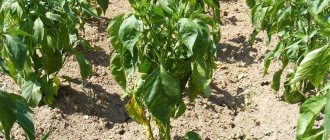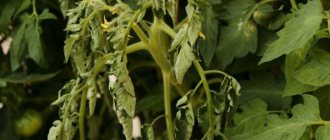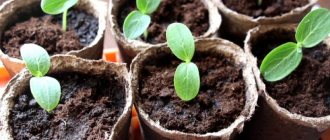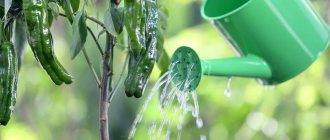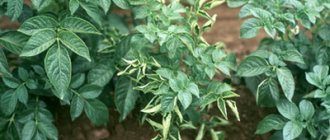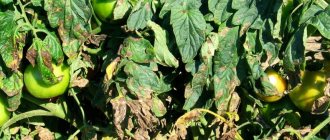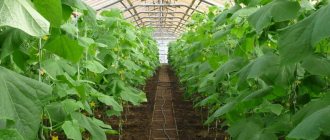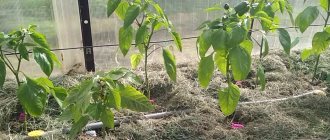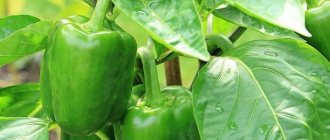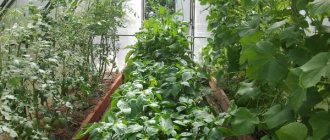Pepper is one of the favorite crops in Russian gardens. It is not very whimsical, but to obtain healthy fruits you must first grow strong and healthy seedlings. Sometimes the stems begin to bend towards the ground, the leaves fall off, and the plant gradually dies. To prevent this condition, you need to figure out why young pepper seedlings fall, adult plants wither and turn yellow, and how to deal with this.
Why do the bushes and pepper leaves in the garden beds wither?
Pepper is native to Central America. Its fruits are bright, juicy, full of vitamins, but the plant itself is capricious and heat-loving and requires careful care. Its varieties differ in yield, germination time and fruit size .
Affects the viability of the plant:
- incorrectly selected soil;
- lack of light;
- too frequent watering;
- non-compliance with temperature conditions, drafts;
- dry air.
Insect pests have a detrimental effect . Even if you want to grow a vegetable organically, you should not neglect pesticides, otherwise the fruit will be eaten before you or the sprout will be destroyed before the ovary appears. Bacterial diseases are also a common cause of wilting.
Attention! When growing peppers, be prepared for the fact that some of them will die for no apparent reason - due to natural selection, that is, as the weakest in the group.
Causes of the problem
To choose a treatment method for peppers, you should find out the source of the problem . The cause of wilting can be determined by the external signs of the affected plants, soil characteristics and current weather conditions.
Diseases
Among the most common diseases that affect pepper are white rot, late blight, gray rot, macrosporiosis, blackleg, septoria, as well as fusarium and verticillium wilt.
White rot, or sclerotinia
Affects the root part of the plant . White fungal mycelium covers the affected areas in a continuous layer, after which black formations appear - sclerotia (hence the name).
Diseased fruits can be distinguished immediately : watery, soft, with a flaky coating. The good news is that white rot usually kills only some plants, but not all. However, it persists in the soil and on affected leaves.
Late blight
It is characterized by large brown spots along the edge of the leaf with a white cobwebby coating of spores on the back, brown and retracted spots on the stems, and rot on the fruits. Infection most often occurs from diseased potato plantings, spread by spores that eventually destroy the entire plant.
Late varieties are more susceptible to infection , since the pathogen prefers the second half of summer and autumn, high temperatures during the day and low at night, high humidity and frequent precipitation.
Gray rot
Appears in plants grown in a film greenhouse . Due to the dense material, humidity rises to extreme levels, which guarantees the development of diseases. A humidity of 80% and a temperature of 10-15°C causes damage to the stems and leaves, primarily the lower ones: brown spots appear with a grayish coating of sporulation.
Pathogens are spread through spores by wind, water and clods of contaminated soil.
Macrosporiasis
There are varieties of peppers that are resistant to macrosporiosis, but not all have immunity. The disease is characterized by brown spots on wilting leaves . Inside you can see a pattern of concentric rings, an increase in the number of which indicates the imminent death of the leaf.
It spreads in warm, humid weather (heat and precipitation). Transmitted through contaminated soil, potato tubers and dry impurities in seeds.
Blackleg
The symptoms of blackleg are clear from the name : the disease affects the stem. It becomes covered with black spots and becomes thinner, the leaves become yellow, and the sprout gradually dies or produces much less yield than a healthy one.
The infection spreads through the soil and is especially dangerous for young shoots. Develops in too moist soil at temperatures from +5°C.
Septoria or white spot
Capable of destroying up to half of the entire crop . It is characterized by white spots with a brownish-purple edge on the leaves, in which spores later form. Over time, the affected leaves become completely white, dry out (first the lower ones, then the upper ones), and the plant dies.
The infection develops in hot and rainy weather . The pathogen does not leave the soil for a long time.
Fusarium wilt
With Fusarium wilt, the leaves turn yellow, wither and droop . Next, the leaves turn pale green or yellow-brown, and the stalk is surrounded by darker depressed areas. The result is the complete death of foliage.
This is due to a fungus that enters the vessels of the stems through the roots. The plant begins to wilt a few days after infection. The disease lasts as long as plant immunity and weather conditions allow. Once it has conquered a territory, the infection can remain in the soil and on plant debris for several years.
Verticillium wilt
Before flowering, the infected plant grows poorly , the areas between the leaves are shortened, and the lowermost leaves become dark green and mottled. Over time, the pathogenic fungi move to the top, affecting the entire plant. They interfere with the formation of ovaries, and the fruits, even if they appear, will be small and sluggish. Microorganisms remain viable for up to 15 years.
A plant can become infected if it is not replanted carefully - the infection gets into the wounds or onto the roots.
Attention! The favorable environment for the development of verticillium is about 25°C heat and unmoistened soil, which is why July and August are considered the most dangerous months.
Pests
In addition to fungal diseases, insect pests pose a danger . The most common are melon aphids, slugs, spider mites and the Colorado potato beetle.
melon aphid
Small, inconspicuous dots on the leaf sometimes cover the entire sprout, appearing on the stems, leaves and flowers. The bug sucks the juices from the plant, causing the leaves to wither, curl and dry out.
Slugs
They attack the plant in smaller quantities than aphids, but this does not reduce the amount of damage. Slugs gnaw leaves and fruits, preventing them from developing. Additionally, land mollusks infect the plant with bacterial diseases.
Spider mite
It is difficult to notice until it begins to weave a web . The mite envelops leaves and fruits in its network, also sucking out all the juices. After its attack, the plant has no chance of productive growth.
Colorado beetle
The Colorado potato beetle lives mainly on potatoes . But if you decide to plant peppers nearby, the likelihood of finding a beetle on it is high. The beetle can also come from eggplants and tomatoes.
Its black and white striped back is hard to miss on the green leaf. The Colorado potato beetle is extremely active: if you ignore its presence in the garden, it can destroy all your plants.
Why do pepper seedlings turn yellow?
Yellowing of pepper leaves can be caused by several reasons. The main ones are:
- Confusion or insufficient development of roots;
- Lack of nutrients;
- Lack of water during irrigation;
- Fungal infection (“black leg”).
Have your pepper seedlings turned yellow? What to do in this case?
Confusion and underdevelopment of roots
This phenomenon occurs most often when planting pepper seeds in small individual containers.
. The roots do not have enough space to develop, which results in a lack of nutrients in the leaves, and subsequently yellowing and falling of the leaves. Only replanting the plant with careful, complete unraveling of the root ball can help.
Nutrient deficiencies
Pepper leaves may turn yellow due to lack of nutrients. According to experienced gardeners, yellowing is most often associated with a lack of nitrogen.
. For more rapid feeding, spraying with ammonium nitrate solution is used. In this case, the leaves will quickly receive nitrogen, but you shouldn’t rely on it alone.
Feeding with preparations containing nitrogen, for example azogran in granules or urea, will help. It will be enough to add one granule to the ground next to the plant.
Important!
Don't expect complete death of the seedlings. You need to find out the cause quickly and eliminate it. Show attention and care to the seedlings in a timely manner.
Lack of water during irrigation
One of the reasons for yellowing of pepper leaves is lack of water during irrigation. According to scientists, pepper is more than 90% water. Seedlings tolerate a lack of moisture extremely poorly; first of all, the flowers and ovary begin to dry out and crumble, then the leaves.
Experienced gardeners, knowing this feature, water the seedlings very carefully, using water at room temperature
. Cold water can also cause leaves to turn yellow and fall off.
Fungal infection
The seedlings turn yellow, the leaves begin to die and fall off. Upon careful inspection, the constriction is clearly visible at ground level. This is the so-called “black leg”. The cause of infection is a soil-transmitted fungus; much less often, infection occurs through a planting container or pepper seeds.
Control measures include treating seeds before planting and disinfecting planting containers.
. If infection does occur, careful sampling and removal of affected plants is necessary. Treat the remaining seedlings with a preparation containing copper.
Attention!
Purchase soil mixture only in specialized stores, otherwise there is a high risk of purchasing low-quality, poorly prepared soil.
Treatment methods
For each problem there is its own treatment method . The main thing is to notice the disease in time and begin to eliminate it. What to do to save the harvest?
Agrotechnical methods
Maintain moderate soil moisture , avoid waterlogging and drought. It is useful to periodically remove withered, diseased leaves before the disease spreads to the stem.
Watch the proximity of plants : it is better not to plant peppers next to potatoes. Periodically destroy weeds that interfere with the proper development of bushes.
If the seedlings are planted in small containers, carefully transplant them into larger pots without damaging the root system , and do not place the containers themselves too close to each other. A mirror or a sheet of foil installed opposite will allow you to provide the plants with light so that they reflect the sun's rays directly onto the sprouts.
Traditional methods
For aphids, the plant is treated with a solution of tobacco dust or wood ash - 1 glass per 10 liters of water. The solution is infused for 24 hours, after which a spoonful of soap is added.
For spider mites - a mixture of dandelion leaves (1 cup) and garlic or onion minced through a meat grinder, dissolved in 10 liters of water with a spoon of soap.
Slugs will move away from soil sprinkled with slaked lime.
Attention! In case of infectious diseases, plants cannot be saved: it is better to dig them up with soil and burn them, so as not to harm the next plantings.
Chemicals
Preparations containing copper and fusarium wilt - copper-containing fungicides will help overcome late blight. Experienced gardeners advise using the Trichodermin biofungicide in a volume of 2 g per plant.
“Keltan” and “Karbofos”, diluted according to the instructions in 10 liters of water, help well against pests After harvesting the fruits - “Commander” (chemical granular metaldehyde).
For diseases, the plant can be sprayed with calcium nitrate or the preparations “Barrier”, “Oxychom”, “Fundazol” - in accordance with the instructions.
Possible mistakes when planting and caring for peppers and overcoming them
Peppers often fall due to the following care errors when growing:
- Excess fertilizers, especially nitrogen-containing ones. You need to be careful with mineral fertilizing; follow the dosage of 0.5 g per 1 liter of water. If the seedlings begin to stretch out due to the high content of fertilizers, this process cannot be stopped.
- Excessive watering. Because of this, the roots and stems rot, a fungal infection begins to develop, because of this the pepper falls, and fruiting does not occur. If the damage is not severe, the seedlings need to be dug up, damaged roots removed and transplanted to a new location, having first disinfected the root system and soil on the site.
- Lack of moisture. Because of this, the leaves of the bell pepper fall off, the roots become dry, and the stems bend. The soil should be checked regularly for sufficient water. To do this, you can stick a match into the ground. If the soil sticks, there is enough liquid. When the stick is dry, it needs watering.
- Operation of heating devices installed near the crop. This leads to dehydration of plant cells. It is necessary to increase the amount of watering and remove heaters away from plants.
- Water the seedlings with cool water. Young plants have not yet had time to get stronger, and they may even die from such actions. The water must be at least +20…+25 °C.
- Crowding when growing in containers or dense plantings when growing in beds.
- Cold drafts.
Pepper can be grown at home as seedlings or directly in open nutrient soil. With the latter option, it is recommended to plant the crop in a greenhouse or greenhouse, because there you can create the most suitable microclimate for proper development. To prevent the stems from bending, the following conditions must be provided:
- When germinating seeds, the temperature should vary between +25…+27 °C. After the first shoots appear, it should be lowered to +20 °C.
- Like any other plant, peppers need light for photosynthesis. When growing in a greenhouse or greenhouse, you need to install devices for additional lighting. They are placed at a height of 50-60 cm from the tops of the bushes.
- Air humidity should vary between 60-65%.
If these rules are followed, sweet bell and bitter peppers will actively develop and produce a good harvest.
Prevention of pepper wilting
Prevention begins with proper planting . In mid-latitudes, peppers are grown only as seedlings, and then in a greenhouse, in soil specially prepared a year before. They need to be planted at a distance of at least 3 cm from each other.
Particular attention should be paid to the soil if diseased plants previously grew in it. It is not recommended to plant peppers in place of potatoes, eggplant or tomatoes. Good predecessors are carrots, dill and onions.
Use only high-quality and proven seeds from healthy fruits, choose disease-resistant varieties and hybrids.
Useful tips
You can provide peppers with a favorable environment for development and fruiting by following the advice of experienced gardeners:
- Be careful about the quality of your seeds. If you are not sure about them, before sowing, for disinfection, first soak for 20 minutes in potassium permanganate, and then, after thoroughly rinsing with water, for 12 hours in the Zircon preparation.
- Don't plant seedlings too early. The optimal time is between mid-March and early April. In this case, you will spend much less time keeping the plant in a stuffy room.
- Remove plant parts remaining in the soil after harvesting. Some of them can leave behind pathogenic fungi, bacteria and viruses that are not afraid of winter. Crop rotation may not be enough - the only effective solution is to burn all plant residues.
Preventive measures
To prevent pepper diseases and pest invasions, preventive measures are taken:
- at the end of the season, carefully remove plant debris and remove 20 cm of the top layer of soil, replacing it with fresh soil;
- before sowing, seeds and soil are disinfected, the inner surface of the greenhouse is treated with antiseptic agents;
- do not allow seedlings to thicken;
- comply with the rules of agricultural technology;
- destroy pests in a timely manner.
